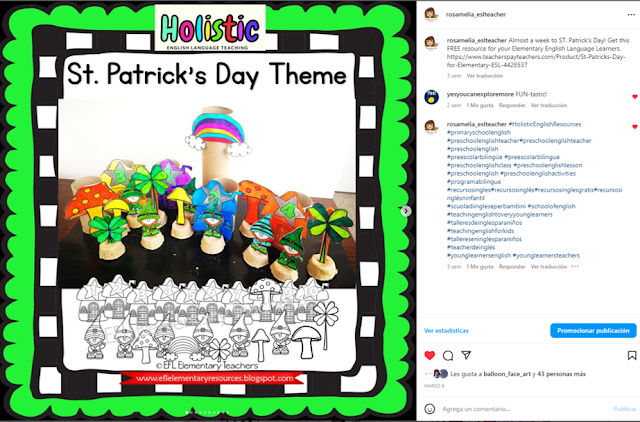Link to the St. patrick's Day resource:
I have always liked this Holiday. In the 90’s I was
teaching after school ESL and this is an old picture of what we did with the
children.
Puppets.
Make puppets with the clovers to review colors.
Teacher: What color is this?
Students: red!
Teacher: It’s a red clover.
Worksheets. Have
the students complete their worksheets to review color words.Then place the worksheet in a clear plastic sheet. Students can trace the words using whiteboard markers and then erase. Save for future worksheets.
I made these colored plates once. I just colored a
paper plate in a different color to do sorting. I am recycling them to sort the
clovers.
I love the scrabble
letters that I made for a product months ago. I am putting them here, you
can use them for every single lesson just for making words or for making a
crossword.
Or use the color letters printables to make the color
words.
Use the writing pad or notebook for writing the color
words.
The
bottle caps printable is free. I made it years ago and have used it a lot. Here
is the link. https://www.teacherspayteachers.com/Product/Number-Bottle-Caps-2155938
More
worksheets. Students color and trace the words in the worksheet.
Then, cut and paste on their notebooks and write a sentence.
Or the students can color and cut each item and glue
them alphabetically.
Listen
and color worksheet.
Teacher: Color their hats green, black and yellow.
Teacher: Color his shirt orange and her blouse orange.
Teacher: Color their shoes black.
Review
colors and numbers at the same time.
Say the color of the numbers in random order.
Teacher: Number seven is orange.
Then,
have the students write the color and number words next to each picture.
They
can cut each number and dictate the order to put them.
Teacher: six, ten, nine, seven.
I found these cute gnomes
images and I had to create something and thought that it could fit for
prepositions. Students can color them and make a gnome village per group. I used toilet paper rolls, paper towels
rolls and carton eggs. I glued the gnomes onto craft sticks and then made a
slit onto the carton egg and placed the gnomes and the rest of the pieces.
I
used them for prepositions. Students
listen and place the gnomes and other items as they listen or they can give the
instructions and the other groups follow.
Teacher: The gnome is next to house number 1.
The gnome is behind house number 3.
The gnome is in front of house number 4.
The clover is behind the yellow house.
A craft. I
grabbed a black plastic plate that I had around the house, cut the middle of
the plate to make a wreath. I glued all the pieces.
Let’s
dress the leprechaun. Dictate the
color for each clothes piece.
That
give directions for gluing them.
Teacher: Color the hat green and the belt is black
with yellow.
Glue the socks on the leprechaun.
More
clothes and body. Color the pictures and label the parts of the
body and the clothing pieces.
And flashcards! Yes, again… use for many games for those dreaded 5 minutes left.

































































